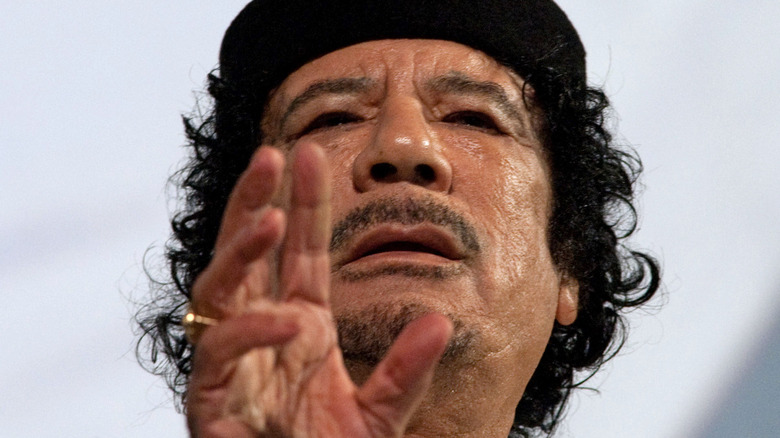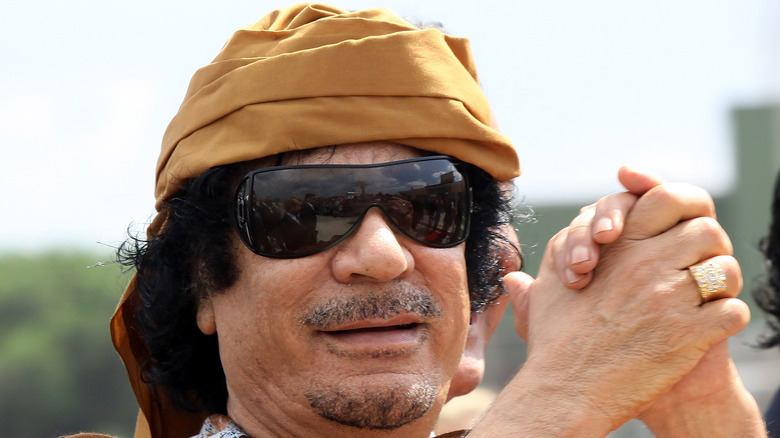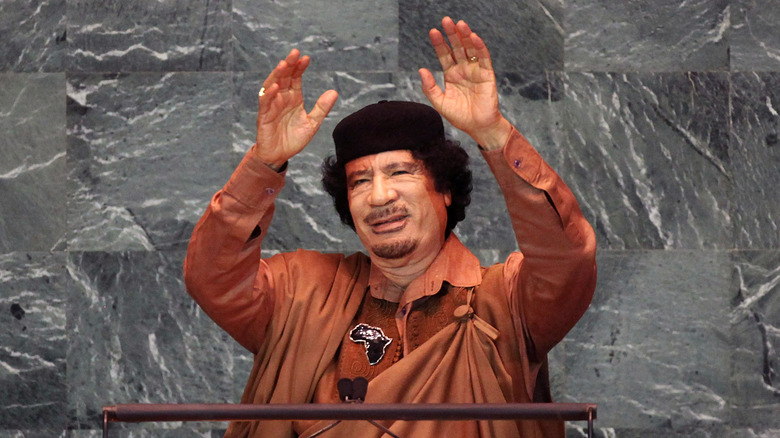The Truth About Muammar Gaddafi's Corpse
At the age of 27, Muammar Gaddafi became ruler of Libya (via Biography). What followed were years of human rights abuses and outlandish displays of power. As an eccentric authoritarian dictator, Gaddafi traveled with female bodyguards and wore an array of colorful outfits (per All That's Interesting).
Like other dictators before him, Gaddafi wrote a book about his ideas. His, published in the 1970s was known as the "Green Book" and promoted his political philosophy. Libyan citizens were required to carry a copy with them at all times, furthering the control he had over the state. Moreover, according to History, he was linked to several terrorist attacks on the West, including the 1988 explosion of a Pan Am flight.
After more than 40 years in power, Gaddafi's reign came to a vicious end in 2011. Inspired by revolts in Egypt and Tunisia (known as the Arab Spring), the Libyan people began to protest. As the uprising erupted, Gaddafi was ruthless toward his people and used violence to suppress them — so much so, that the country descended into civil war (via the University of Illinois). Soon, the UN authorized military intervention to protect civilians against Gaddafi's wrath.
His forces fired ammunition at protestors and decimated cities as his forces fought the rebel NTC (via Al Jazeera). With help from the UN, NATO, the West, and other Arab states, Tripoli fell to the NTC (per BBC). After six months of fighting and thousands dead, Gaddafi fled (per BBC). On October 20, 2011, Gaddafi was captured and killed, ending a 42-year-long reign of terror.
Gaddafi's rule was brutal and marked by human rights abuses
It's unsurprising to learn that Gaddafi's regime was totalitarian. According to the BBC, he created his own system of government and backed up radical armed groups. Furthermore, he banned all private enterprises, burned books, and was a master manipulator. Freedom of speech in Libya did not exist and if anyone spoke out against Gaddafi, it was certain that violence would follow. He also hoarded the wealth Libya's oil provided him with. Thus, the Libyan people lived in poor conditions and had a high unemployment rate. In other words, every aspect of daily life was under Gaddafi's control.
Although the government denied these allegations, Gaddafi's son admitted there'd been human rights abuses (via Reuters). In the 1970s, it is said that there were various televised public hangings and mutilations of those who opposed Gaddafi. He executed citizens and used violence to suppress student demonstrations. His fury extended abroad to dissidents, and they too were executed. People were arrested, tortured, or sentenced to death. In 1996, Gaddafi allegedly ordered for 1000 prisoners to be shot dead.
Per The Guardian, these human rights violations led to a third of the population having mental health issues, even years after Gaddafi's death. Most citizens have had a family member disappear or be killed. Likewise, those who have been arrested described being beat or tortured. The Libyan people reported high levels of anxiety, depression, and in general, fear about uncertainty and life. Despite this, in 2014, a report noted a general improvement in life after Gaddafi's removal.
His body was displayed at a meat market
Per BBC, the exact circumstances of Gaddafi's death are disputed. What is known, however, is that Gadafi was in his hometown of Sirte and had been in a convoy that was attacked. Gaddafi and some of his men escaped and hid in sewage pipes (via Al Jazeera).
They were discovered and accounts describe that Gaddafi had been shot in one of his legs, his back, and chest. He was placed in an ambulance and here's where things get murky. Some claim he died in the ambulance, while others say that an attack mid-transport ultimately led to his death. Nonetheless, he died before reaching a hospital and an autopsy later found a bullet would on the left side of his head, as well as one in his abdomen (via ABC News).
After his death, Gaddafi's body was put on display at a meat market (per The Guardian). According to Reuters, his corpse was put in a cold storage room as the public lined up to view and photograph him. The smell of decay was so bad, guards handed out surgical masks.
Part of the reason for the unceremonious display was that authorities didn't know what to do with the body. Gaddafi's family wanted to bury him in Sirte, however, the Libyan government wanted him buried in an undisclosed location to prevent his grave from becoming a shrine or a target for his adversaries.
After five days on display, Gaddafi was given an Islamic burial and buried in the Libyan desert in an unmarked grave. Those who lined up to view him at the meat market had no remorse for him, even going as far as saying that Gaddafi was "not human."


